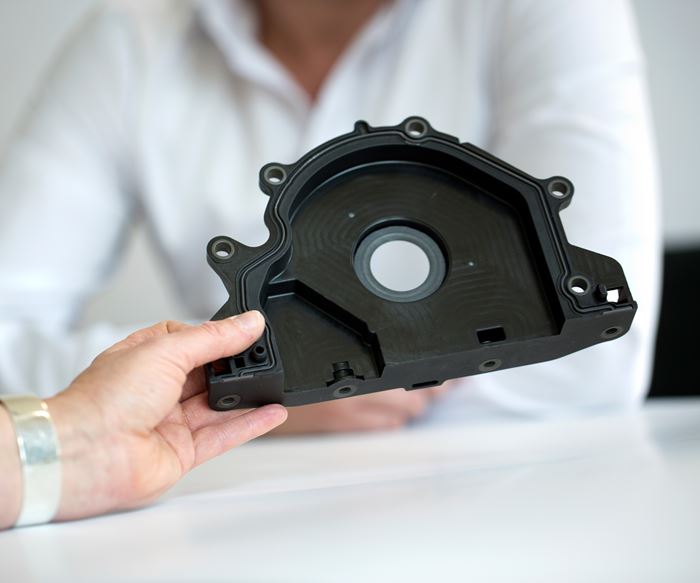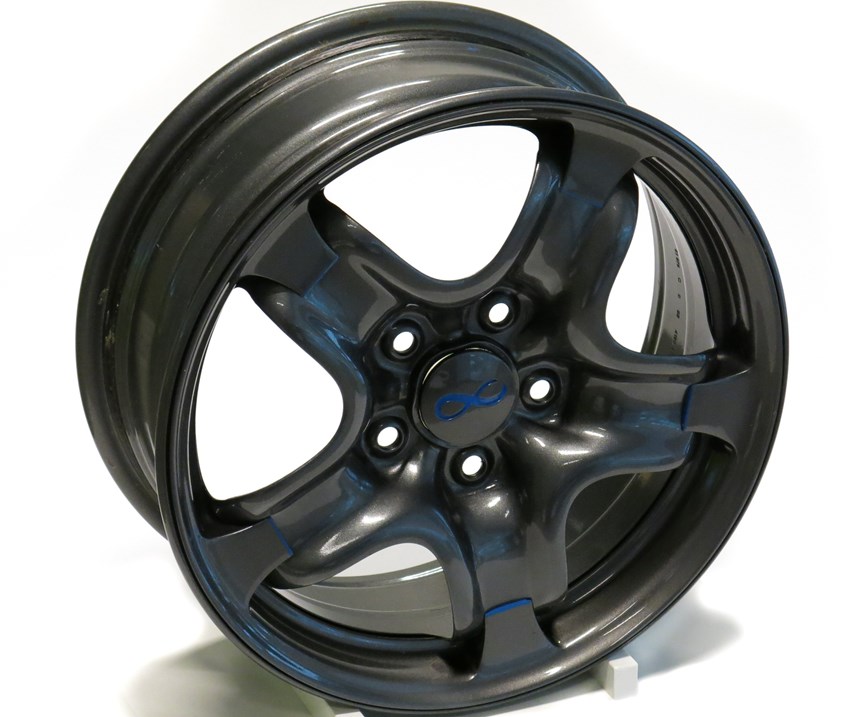Share
Bio-based resin systems are not new to composites manufacturing. In fact, bio materials have been used as feedstock in some resin systems for more than a decade, starting with soybean oil and corn ethanol used in unsaturated polyester and progressing to sugar cane, lignin, vegetable oils, glycerols and other plant-based biomasses. Such materials have been marketed primarily as greener alternatives to traditional hyrdrocarbon-based resins, designed to reduce the carbon footprint of the final product in which they are used. However, despite their wide availability, bio-based resins have struggled to displace their petroleum-based predecessors. That is starting to change, however, and evidence of this can be found in the automotive composites market.
This is where DSM Engineering Plastics (Geleen, The Netherlands) finds itself with its EcoPaXX PA 410, a bio-based polyamide that has been certified as carbon neutral, thanks in the main to its being 70% derived from the castor oil bean plant. This resin is available in a number of glass fiber- and carbon fiber-filled versions, as well as in a line of unidirectional (UD) tapes that are targeted toward automotive parts. The automotive environment is a good fit with the polymer’s high-temperature stability, enhanced hydrophobicity compared with other polyamides, and superior oil and chemical resistance.
One of the first commercial applications of EcoPaXX, a crankshaft cover on Volkwagen’s MDB-4 TDI diesel engines used in a variety of car models made by VW, Audi and others, won a 2014 Society of Plastics Engineers (SPE) Innovation Award in the Powertrain category, replacing a die-cast aluminum cover with a resulting weight savings of 40% and a total production system cost savings of 25%. The part, manufactured by KACO GmbH (Kirchardt, Germany), comprises a 50% chopped glass fiber, injection molding grade of EcoPaXX insert molded over a plasma-activated, dynamic PTFE seal, with a liquid silicone rubber static seal. KACO developed the patented PTFE seal process, which is said to reduce friction and improve engine efficiency.
The crankshaft cover is approximately 200 mm long by 120-140 mm wide by 2-4 mm thick. In operation, the interior of the part is fully immersed in oil. Ronald Ligthart, DSM’s global technical product manager, Stanyl and EcoPaXX, says for this application, the 410 polymer is competing with polyamide 46 and 66, as well as polyphthalamide (PPA). He notes that while the EcoPaXX 410 molecule provides similar mechanical properties to PA 66 and PA 46 (the polymer comprising DSM’s Stanyl line of resins), it is the combination of the 4 monomer (1-4 diamino butane) with the 10 monomer (sebacic acid), that imparts enhanced chemical, oil and water resistance compared to these other material options.
“The aliphatic, hydrophobic nature of the 10 monomer acts as a counterbalance to the hydrophilic properties of PA 46 and 66, which is critical for a part such as the crankshaft cover as it provides better dimensional stability in the high heat and humidity found under the hood,” says Ligthart. When customers are looking for improved dimensional stability and/or improved hydrolysis/chemical resistance versus PA 66 in these conditions, he says EcoPaXX is an improved, drop-in replacement for PA 66 molds.
The molecular structure of EcoPaXX also provides the glass-filled injection molding grade, formally QHG10, with low viscosity and high temperature stability — properties that are said to make it easy to mold. “The processing window of PA 66 is very restricted, typically to a range of 20-30°C; however, with EcoPaXX, as a consequence of the 10 monomer, the processing window is really wide, in the range of 250-350°C, which gives the molder a lot of flexibility to fine-tune the flow during processing,” reports Ligthart.
UD Tapes target automotive lightweighting
Looking to the future, DSM is planning installation in 2019 of a production line for rolls of 1m-wide continuous glass fiber- and carbon fiber-reinforced EcoPaXX tapes, as well as tapes made from its other polyamide resins, such as Stanyl. The EcoPaXX tapes were initially developed from 2012 to 2016 as part of a consortium project sponsored by the European Union, ENLIGHT, comprising automotive OEMs and suppliers. The goal was to accelerate development of new lightweight materials and processes for automotive manufacturing.
DSM, the sole materials supplier in the project, formulated EcoPaXX tapes, in part, as a response to the project’s near-term objective for cost-effective, bio-based thermoplastics to reduce weight and the carbon impact for application in medium- to high-volume electric vehicle production by 2020-2025, for specific car sub-systems, including the subframe and suspension, front module and cross-car door beams and enclosures.
Raj Mathur, DSM global R & T manager, advanced thermoplastics composites, reports the material and mechanical properties of the tapes were first characterized by standard lab testing. The material data was then used as input for finite element analysis simulations — for example, side pole crash tests of door panels. In the final phase of the project, DSM and partners demonstrated viable manufacturing techniques by weaving the UD tape into non-crimp fabrics and then thermoforming and joining the door panel sections, and other demonstrator parts, into final shape.
Currently, DSM offers grades of glass fiber- and carbon fiber-reinforced EcoPaXX UD tape produced on a pilot production line in rolls 600 mm wide and up to 300m long, typically 0.20 to 0.30-mm thick, with a fiber content of 50-60%. Mathur says customers typically slit the tape to widths (+/- 0.1 mm) appropriate for the application. In conjunction with the ENLIGHT project, DSM has tested and confirmed that the tapes are compatible with a handful of manufacturing processes, including tape winding, metal-composite hybrid fabrication and automated tape layup (ATL) combined with thermoforming and injection overmolding. The latter process was proved out in a demonstrator part produced with geometries typically found in automotive parts such as engine and battery covers. To manufacture the part, first an ATL machine equipped with a robotic arm and trailing roller lays down a laminate up to 4 mm thick. This laminate is then thermoformed to final shape in a process similar to metal stamping. Finally, the part is fixed in a tool and injection overmolded to add features to the part, such as ribs and bosses.
One of the more promising, long-term commercial applications entails a collaboration between Maxion Wheels (Konigswinter, Germany) and DSM in the development of the metal-hybrid MaxFiber Steel Wheel. One of the goals with the wheel was to decrease the original steel wheel rim section thickness to 1 mm (from 2 mm), compensating by wrapping the rim with 60% glass fiber-filled UD EcoPaXX tape in three locations: the center “groove,” called the Drop Well, and two side grooves, one on the left and right, termed the Bead Well (see photo). The tape wound in the Drop Well is twice as wide as the tape wound in the two Bead Wells. The EccoPaXX resin was formulated with conductive additives in order to absorb laser energy during winding and curing. The reduced steel use and subsequent winding with glass fiber-reinforced tape resulted in about 2 kg of weight savings per standard 16-inch passenger car wheel, and about 6 kg of weight savings per standard truck wheel.
The critical benchmark for success of the project, Mathur reports, was passing the SAE J328 Radial Fatigue Test, which simulates a wheel/tire assembly in normal operation as it would with a standard vehicle load. During the test, over time, the load is multiplied, thus simulating the life cycle of a wheel in a relatively short time. While there are several loading tests required to validate a new wheel, the J328 is the test that most directly affects the wheel in the reinforced area. Mathur says the test results showed the tape-wound wheel had an improved strength and fatigue-resistance of about 30%, compared to a standard steel wheel control of the same dimensions and thickness, proving the feasibility of validating the wheel design for full commercial operation.
While testing on the MaxFiber wheel is ongoing, Mathur says the value proposition of the wheel is better for commercial trucks rather than passenger cars as trucks have heavier, and more, wheels. With an average of six wheels per truck, at a minimum 6 kg of weight savings per wheel, the total weight savings of 36 kg “adds up to a sufficiently high number to attract the attention of commercial truck operators,” says Mathur.
The development work on the hybrid metal-composite wheels revealed another appealing attribute of the EcoPaXX tapes: When consolidated into a laminate, the tapes have a higher interlaminar shear strength than many other typical glass fiber-filled thermoplastic and thermoset laminates, reports Mathur. “Compared to composites in general, which have interlaminar shear values typically in the range of 50-60 MPA, EcoPaXX is 80-90 MPA. This means a fabricator or designer can use less material to make parts with the required structural properties.”
As with composite tape products in general, the EcoPaXX tape has an inherent cost advantage compared with parts cured in an autoclave. Mathur says that to ensure the commercial viability of EcoPaXX, and the company’s line of thermoplastic composite tapes in general, DSM is working with equipment suppliers to reduce fabrication costs, maximize throughput and reduce cycle times. Ultimately, DSM would like to see cycle times closer to 1 minute, which would put the material and process on par with automotive industry standards.
Related Content
Jeep all-composite roof receivers achieve steel performance at low mass
Ultrashort carbon fiber/PPA replaces steel on rooftop brackets to hold Jeep soft tops, hardtops.
Read MoreCryo-compressed hydrogen, the best solution for storage and refueling stations?
Cryomotive’s CRYOGAS solution claims the highest storage density, lowest refueling cost and widest operating range without H2 losses while using one-fifth the carbon fiber required in compressed gas tanks.
Read MoreCarbon fiber, bionic design achieve peak performance in race-ready production vehicle
Porsche worked with Action Composites to design and manufacture an innovative carbon fiber safety cage option to lightweight one of its series race vehicles, built in a one-shot compression molding process.
Read MoreAutomotive chassis components lighten up with composites
Composite and hybrid components reduce mass, increase functionality on electric and conventional passenger vehicles.
Read MoreRead Next
Developing bonded composite repair for ships, offshore units
Bureau Veritas and industry partners issue guidelines and pave the way for certification via StrengthBond Offshore project.
Read MorePlant tour: Daher Shap’in TechCenter and composites production plant, Saint-Aignan-de-Grandlieu, France
Co-located R&D and production advance OOA thermosets, thermoplastics, welding, recycling and digital technologies for faster processing and certification of lighter, more sustainable composites.
Read MoreAll-recycled, needle-punched nonwoven CFRP slashes carbon footprint of Formula 2 seat
Dallara and Tenowo collaborate to produce a race-ready Formula 2 seat using recycled carbon fiber, reducing CO2 emissions by 97.5% compared to virgin materials.
Read More

























